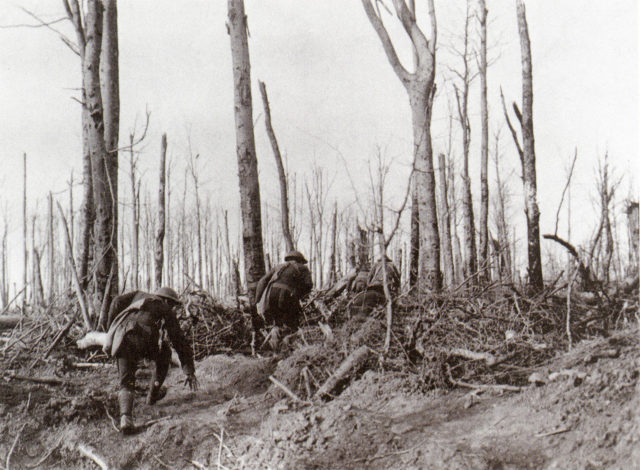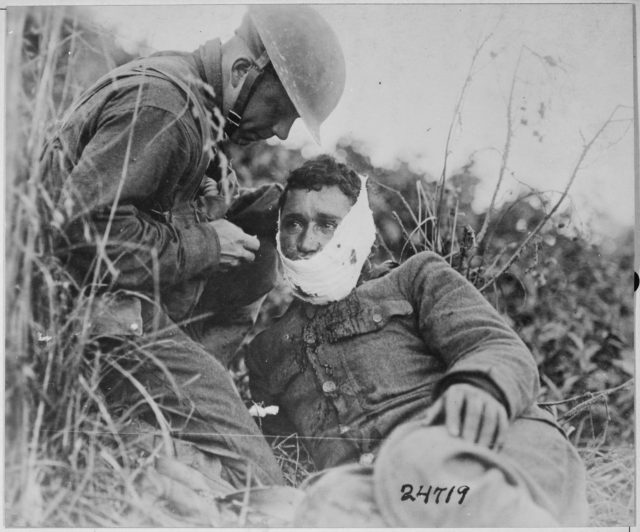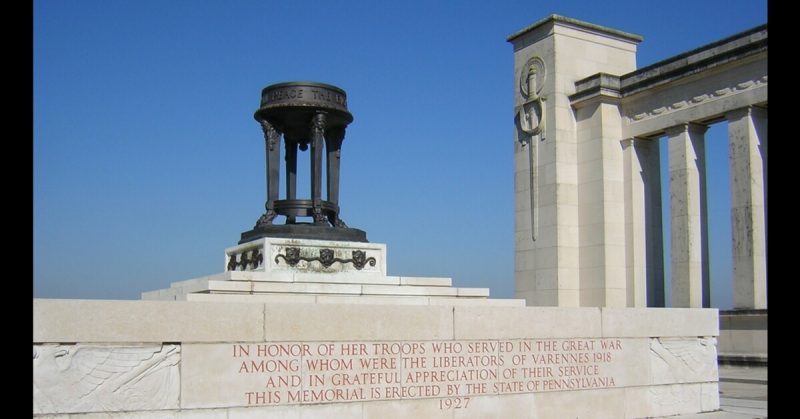The Meuse-Argonne Offensive was the largest American military operation of the First World War. Engaging over a million American soldiers throughout the last months of the war, it began with a few days of hard fighting as the Americans launched their assault on the Argonne Forest.
The Challenge of the Argonne
In the autumn of 1918, the Allies undertook a massive push to drive back the German army. In late September, the Americans were tasked with advancing from the front line just south of the Argonne Forest.
It was awkward terrain in which to launch an attack. 600,000 soldiers, 93,000 horses, and all their equipment had to be brought 60 miles to the front using only three minor roads. The Germans were dug in on high ground, and the attacks would have to be launched up steep hills and small mountains as well as through forests.
Despite their inexperience and logistical challenges, the Americans got their troops into place, ready to launch an attack on September 26.
The German Defenses
The Germans had been digging in along this line since 1915. In keeping with their strategy all along the Western Front, they had built strong defenses. They had intended to hold their position until their war on the Eastern Front ended, and more troops could be brought into the fight.
Three lines of defenses faced the Americans, with a fourth under construction to the rear. They featured well-constructed trenches, deeply dug bunkers, concrete pillboxes and blockhouses, fortified farms, belts of barbed wire, and a network of communication trenches connecting them together.
Artillery Fire
At 2330 on September 25, the American barrage began. Long range artillery pounded the German positions, joined three hours later by divisional artillery.
General Pershing’s experienced troops were exhausted from the previous fighting and were not involved. Most of the Americans preparing for the attack were fresh troops who had seen little of war. Many found the noise and light of the night-time artillery attack overwhelming.
Patton’s Tank Attack
At 0530, 59 tanks of the 354th Battalion, 1 Tank Brigade, began to advance alongside the 137th and 138th Infantry Regiments. Lieutenant-Colonel George Patton, lead the 354th in their attack.

As the fog lifted at 0915, German guns began shelling the tanks. The American vehicles were forced off the road to get around two disabled French tanks. They kept up the advance, storming the trenches around Cheppy and taking the village.
Patton was severely injured in the fighting. It was the last action he saw in WWI.
Cheppy Woods
The 91st Division reached Cheppy Wood with barely any challenge. As the fog lifted, they came under fire from German machine-guns in the woods and artillery at Butte de Vauquois. Over the course of the day, they pushed the Germans back, taking the village of Véry. There they dug in for the night, having advanced five miles in a day; more than the Allies had advanced in any offensives during the war.
Behind them, engineers rebuilt roads up to Cheppy Wood to enable supplies to be brought forward.
Tougher Times
Some American units faced a harder time advancing.
The 77th Division were held up by tough bunkers around the Abri de Kronprinz. In the Aire Valley, the 28th Division suffered flanking fire from the forest, as all troops in the area would for the next few weeks. The 79th Division tried to storm Montfaucon, where the Germans held commanding heights. The German artillery devastated the advancing Americans.
In the Air
Air support was relatively thin, as the British and French flyers were busy elsewhere. The American airmen shot down four balloons and 15 aircraft. They launched a bombardment on the Germans at Dun-sur-Meuse, to disrupt supply lines.
The German Response
At first, the German commander, General Max von Gallwitz, thought the attack was a diversion. He assumed it was a distraction for a fresh attack in the Woevre.
As it became apparent the Argonne offensive was the main American attack; he diverted troops into the area. Given the strength of the defenses there, he felt confident they could hold out against the inexperienced Americans.
Coordination Problems
Von Gallwitz was right. Although his first line of defense fell quickly, the second proved much tougher.
The heights at Montfaucon took three days to seize. Only after flanking the peak on both sides could the Americans make a successful assault.

In the forest, German troops ambushed the Americans as they advanced. Some Americans got lost amid the trees.
The swift advances created problems with coordination. Moving at different speeds, the infantry and tanks became separated. At noon on September 28, tanks took the town of Apremont, but it was not until that evening a small group of infantry arrived to hold the town, a task for which the tanks were ill-suited.
Problems Behind the Lines
Behind the lines, there were more problems.
The ground the Americans were advancing over had been no man’s land for nearly four years. The roads had been wrecked and engineers hurried to build new ones. They were then destroyed by a combination of enemy shelling and heavy wear from moving tanks and artillery.
The first day was dry, but then it rained. As at Ypres, the shattered ground turned to mud, bogging down the advance.
When the French Prime Minister Clemenceau tried to visit Montfaucon on September 29, he was prevented not by the fighting but by chaos on the roads.
Coming to a Halt
By the end of September, the swift advance had become a slow grind. The veterans of the 2nd Division had been sent to assist the French. The units who made the initial attacks were exhausted, and those who took their place became bogged down in transport problems.
The fighting in the Argonne had gotten off to a good start, but its momentum could not be sustained.
Source:
Martin Marix Evans (2002), Over the Top: Great Battles of the First World War.
